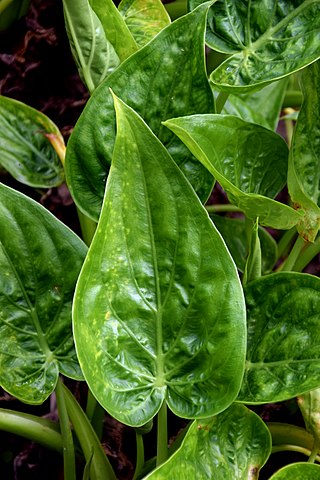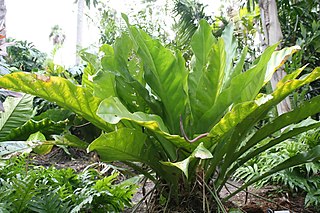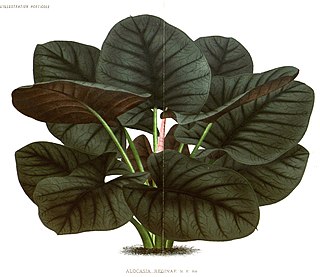
Alocasia odora, also known as night-scented lily, Asian taro or giant upright elephant ear, is a species of flowering plant native to East and Southeast Asia. Traditionally, A. odora is sometime used as a medicine for the treatment of the common cold in Vietnam.

Alocasia cucullata is a species of flowering plant in the arum family known by the common names Chinese taro, Chinese ape, Buddha's hand, and hooded dwarf elephant ear. It is kept as an ornamental plant.

Plectranthus ciliatus, called Indian borage, speckled spur flower, blue spur flower, and candlestick plant, is a species of flowering plant in the family Lamiaceae. It is native to South Africa and Eswatini, and introduced to Victoria in Australia and the North and South Islands of New Zealand. With its Coleus‑like foliage, its cultivar 'Easy Gold' has gained the Royal Horticultural Society's Award of Garden Merit as an ornamental.
Tulbaghia natalensis, called pink wild garlic and sweet wild garlic, is a species of flowering plant in the family Amaryllidaceae, native to the Cape Provinces and KwaZulu-Natal in South Africa. It has gained the Royal Horticultural Society's Award of Garden Merit as an ornamental.

Raoulia australis, the scabweed or scab plant, is a species of flowering plant in the family Asteraceae, native to New Zealand. It is used as a ground cover.

Anthurium crenatum, the scalloped laceleaf, is a species of flowering plant in the family Araceae, native to the Dominican Republic, Puerto Rico, and the U.S. Virgin Islands, and introduced to the Venezuelan Antilles. With its large, textured leaves it is suitable for containers.

Anthurium cubense is a species of flowering plant in the family Araceae, native to southeastern Mexico, Central America, Cuba, Colombia, and Venezuela. A large species, it is occasionally kept as a hothouse specimen or as a house plant. With Anthurium pendulifolium, it is a parent of the 'Big Bill' hybrid cultivar, with leaves exceeding 10 ft (3 m).
Stachys minor, the little betony, small betony, or dwarf lamb's ear, is a species of flowering plant in the family Lamiaceae, native to southern Turkey. A perennial with showy flowers and a spreading habit, and hardy in USDA zones 6 through 9, it is recommended for borders, edging, rock gardens, and containers.
Alocasia reversa is a species of flowering plant in the family Araceae, native to Borneo. In its native habitat it is found on limestone outcrops, so as a houseplant it does not need heavy watering. It gets its specific epithet from the fact that its color pattern is reversed from the typical Alocasia, that is, its coloration is darker on and near the veins.
Alocasia infernalis is a species of flowering plant in the family Araceae, native to Kalimantan, Indonesia and Sarawak state, Malaysia. It gets its specific epithet from its dark leaves—nearly black with purple veins—that exhibit a baleful red iridescence depending on the angle of the light and the position of the viewer. Occasionally kept as a houseplant, it has been nicknamed "Black Magic". Other names associated with Alocasia infernalis, which may represent incipient common names, or cultivars, include "Black Panther", 'Kapit', and 'Viery'.

Alocasia nebula is a species of flowering plant in the family Araceae, native to Sarawak state, Malaysia. As a houseplant it is said to be the most difficult Alocasia to grow.
Alocasia melo is a species of flowering plant in the family Araceae, native to Sabah state in Malaysia. It grows on ultramafic soils. In the houseplant trade it is often sold as "Alocasia rugosa" due to its highly rugose leaves.

Alocasia reginae is a species of flowering plant in the family Araceae, native to Borneo. Occasionally kept as a houseplant, there are cultivars available, including 'Miri' and 'Elaine'.
Alocasia venusta is a species of flowering plant in the family Araceae, found only in the vicinity of the limestone Niah Caves of northern Sarawak, Malaysia. A lithophyte with narrow, canoe-shaped leaves, it is considered obscure even by Alocasia enthusiasts and is rarely found in commerce.

Alocasia reginula, black velvet, is a species of flowering cormous aroid, native to Sabah state in Malaysia. This plant, often referred to as one of the "jewel" Alocasias, became increasingly popular among plant hobbyists between the years 2018 to 2020. Until as recently as 2021 though, not much was known about the plant or its origins. Originally described from cultivation, and often sold as “Alocasia 'Black Velvet'”, it is not a modern cultivar or hybrid; A. reginula is its own natural species. It is only known from dry, deeply shaded limestone cliffs in Tabin Wildlife Reserve. As a houseplant it needs sharp drainage or it will very likely rot.

Alocasia portei is a species of flowering plant in the family Araceae, native to Luzon in the Philippines. With Alocasia odora it is the pollen parent of the large landscaping plant Alocasia × portora.

Alocasia brancifolia is a species of flowering plant in the family Araceae, native to the Moluccas and New Guinea. With its heavily dissected leaves it is sometimes kept as a houseplant. There appears to be a cultivar, 'Pink Passion', in which the markings on the petioles are pink instead of the usual brown.
Alocasia chaii is a species of flowering plant in the family Araceae, native to Sarawak state, Malaysia. Occasionally cultivated for its coriaceous leaves that remain peltate even when mature, it is considered obscure even by Alocasia enthusiasts and is very rarely found in commerce.
Cereus lamprospermus is a species of cactus in the subfamily Cactoideae, native to Bolivia and Paraguay. C. lamprospermus subsp. colosseus reaches 50 ft (15 m), while C. lamprospermus subsp. lamprospermus "only" reaches 30 ft (9 m).

Senna lindheimeriana, the velvet leaf senna, is a species of flowering plant in the family Fabaceae. It is native to the US states of Arizona, New Mexico, and Texas, and to eastern Mexico. A perennial typically 1.5 m (5 ft) tall, it is hardy to USDA zone 8a, and is recommended for xeriscaping and for feeding birds, butterflies and bumblebees. It is thought to be lethally toxic to livestock, but is so foul-smelling and unpalatable that only starving mammals will consume it.













